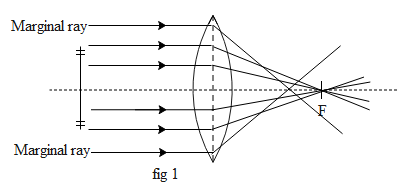
Answer
433.5k+ views
Hint: A crossed lens is basically a lens of the same material but the radius of curvatures for both the lenses are different. This is basically done to reduce spherical aberration. Let us say a lens consists of two different radius of curvatures i.e. ${{\text{R}}_{\text{1}}}\text{ and }{{\text{R}}_{\text{2}}}$. The relation between These two radius of curvatures such that they reduce spherical aberration is given by $\dfrac{{{R}_{1}}}{{{R}_{2}}}=\dfrac{2{{\mu }^{2}}-\mu -4}{\mu (1+2\mu )}...(1)$. Hence from this expression we can obtain the required ratio.
Complete step by step answer:
To begin with let us first understand what does spherical aberration mean from the below diagram.

In the above diagram fig 1we can see that the marginal rays and the paraxial rays meet the optical axis at two different points. This phenomenon is defined as the spherical aberration. This aberration cab be reduced by increasing the thickness of the lens at the periphery of the lens. Hence lenses with two different radius of curvatures are made such that the marginal rays suffer less deviation. Figure below fig 2 shows an example of crossed lens to reduce aberration.

In the above diagram let us say the lens of two different radius of curvatures are made of the same material. Hence from equation 1 the ratio of their radius of curvature is given by,
$\begin{align}
& \dfrac{{{R}_{1}}}{{{R}_{2}}}=\dfrac{2{{\mu }^{2}}-\mu -4}{\mu (1+2\mu )} \\
& \dfrac{{{R}_{1}}}{{{R}_{2}}}=\dfrac{2{{\left( 1.5 \right)}^{2}}-1.5-4}{1.5(1+2\left( 1.5 \right))} \\
& \dfrac{{{R}_{1}}}{{{R}_{2}}}=\dfrac{4.5-1.5-4}{1.5\left( 4 \right)}=\dfrac{-1}{6} \\
\end{align}$
Hence the correct answer to the above question is option b.
Note:
The basic cause of aberration in the lens is the aperture of the lens and it’s thickness. There are many other ways as well wherein spherical aberration can be reduced. One of the ways is stopping the marginal rays from entering the lens. It is to be noted that till now there are no strategies generated such that the aberration is reduced to zero.
Complete step by step answer:
To begin with let us first understand what does spherical aberration mean from the below diagram.

In the above diagram fig 1we can see that the marginal rays and the paraxial rays meet the optical axis at two different points. This phenomenon is defined as the spherical aberration. This aberration cab be reduced by increasing the thickness of the lens at the periphery of the lens. Hence lenses with two different radius of curvatures are made such that the marginal rays suffer less deviation. Figure below fig 2 shows an example of crossed lens to reduce aberration.

In the above diagram let us say the lens of two different radius of curvatures are made of the same material. Hence from equation 1 the ratio of their radius of curvature is given by,
$\begin{align}
& \dfrac{{{R}_{1}}}{{{R}_{2}}}=\dfrac{2{{\mu }^{2}}-\mu -4}{\mu (1+2\mu )} \\
& \dfrac{{{R}_{1}}}{{{R}_{2}}}=\dfrac{2{{\left( 1.5 \right)}^{2}}-1.5-4}{1.5(1+2\left( 1.5 \right))} \\
& \dfrac{{{R}_{1}}}{{{R}_{2}}}=\dfrac{4.5-1.5-4}{1.5\left( 4 \right)}=\dfrac{-1}{6} \\
\end{align}$
Hence the correct answer to the above question is option b.
Note:
The basic cause of aberration in the lens is the aperture of the lens and it’s thickness. There are many other ways as well wherein spherical aberration can be reduced. One of the ways is stopping the marginal rays from entering the lens. It is to be noted that till now there are no strategies generated such that the aberration is reduced to zero.
Recently Updated Pages
How many sigma and pi bonds are present in HCequiv class 11 chemistry CBSE

Mark and label the given geoinformation on the outline class 11 social science CBSE

When people say No pun intended what does that mea class 8 english CBSE

Name the states which share their boundary with Indias class 9 social science CBSE

Give an account of the Northern Plains of India class 9 social science CBSE

Change the following sentences into negative and interrogative class 10 english CBSE

Trending doubts
Differentiate between homogeneous and heterogeneous class 12 chemistry CBSE

Difference between Prokaryotic cell and Eukaryotic class 11 biology CBSE

Difference Between Plant Cell and Animal Cell

Fill the blanks with the suitable prepositions 1 The class 9 english CBSE

Which are the Top 10 Largest Countries of the World?

Give 10 examples for herbs , shrubs , climbers , creepers

10 examples of evaporation in daily life with explanations

The Equation xxx + 2 is Satisfied when x is Equal to Class 10 Maths

Why is there a time difference of about 5 hours between class 10 social science CBSE



